Establishment of Regional Concentration–Duration–Frequency Relationships of Air Pollution: A Case Study for PM2.5
Abstract
1. Introduction
2. Materials and Study Area
3. Methods
3.1. Derivations of PM2.5 CDF
3.2. Empirical PM2.5 CDF Function
3.3. Regional CDF Mapping of Extreme PM2.5
4. Results and Discussion
4.1. Descriptive Statistics and Plots of Extreme PM2.5 Concentration
4.2. Heterogeneity of Air Pollution
4.3. Regional CDF Analysis
4.4. Discussion
5. Conclusions
Author Contributions
Funding
Acknowledgments
Conflicts of Interest
Appendix A
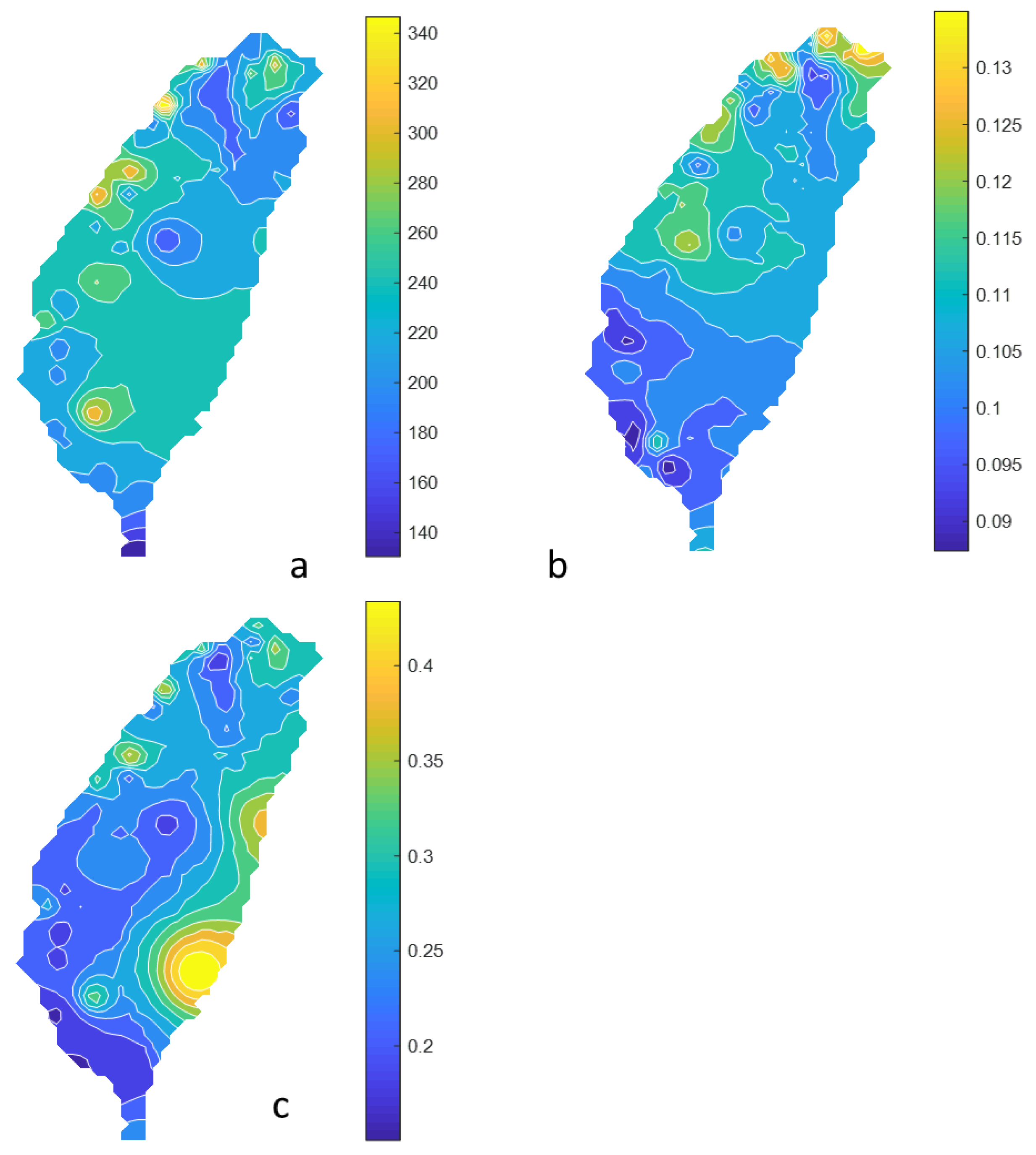
References
- Mannucci, P.M.; Franchini, M. Health effects of ambient air pollution in developing countries. Int. J. Environ. Res. Public Health 2017, 14, 1048. [Google Scholar] [CrossRef] [PubMed]
- West, J.J.; Cohen, A.; Dentener, F.; Brunekreef, B.; Zhu, T.; Armstrong, B.; Bell, M.L.; Brauer, M.; Carmichael, G.; Costa, D.L. What We Breathe Impacts Our Health: Improving Understanding of the Link between Air Pollution and Health; ACS Publications: Washington, DC, USA, 2016. [Google Scholar]
- Klemm, R.J.; Thomas, E.L.; Wyzga, R.E. The impact of frequency and duration of air quality monitoring: Atlanta, GA, data modeling of air pollution and mortality. J. Air Waste Manag. Assoc. 2011, 61, 1281–1291. [Google Scholar] [CrossRef] [PubMed]
- Bai, L.; Wang, J.; Ma, X.; Lu, H. Air pollution forecasts: An overview. Int. J. Environ. Res. Public Health 2018, 15, 780. [Google Scholar] [CrossRef] [PubMed]
- Anderson, J.O.; Thundiyil, J.G.; Stolbach, A. Clearing the air: A review of the effects of particulate matter air pollution on human health. J. Med. Toxicol. 2012, 8, 166–175. [Google Scholar] [CrossRef]
- Katsouyanni, K.; Touloumi, G.; Spix, C.; Schwartz, J.; Balducci, F.; Medina, S.; Rossi, G.; Wojtyniak, B.; Sunyer, J.; Bacharova, L. Short term effects of ambient sulphur dioxide and particulate matter on mortality in 12 European cities: Results from time series data from the APHEA project. BMJ 1997, 314, 1658. [Google Scholar] [CrossRef]
- Li, C.-Y.; Wu, C.-D.; Pan, W.-C.; Chen, Y.-C.; Su, H.-J. Association between Long-Term Exposure to PM2.5 and Incidence of Type 2 Diabetes in Taiwan: A National Retrospective Cohort Study. Epidemiology 2019, 30, S67–S75. [Google Scholar] [CrossRef]
- Cortez-Lugo, M.; Ramírez-Aguilar, M.; Pérez-Padilla, R.; Sansores-Martínez, R.; Ramírez-Venegas, A.; Barraza-Villarreal, A. Effect of personal exposure to PM2.5 on respiratory health in a Mexican panel of patients with COPD. Int. J. Environ. Res. Public Health 2015, 12, 10635–10647. [Google Scholar] [CrossRef]
- Liu, H.-Y.; Dunea, D.; Iordache, S.; Pohoata, A. A review of airborne particulate matter effects on young children’s respiratory symptoms and diseases. Atmosphere 2018, 9, 150. [Google Scholar] [CrossRef]
- Ercelebi, S.G.; Toros, H. Extreme value analysis of Istanbul air pollution data. CLEAN–Soil Air Water 2009, 37, 122–131. [Google Scholar] [CrossRef]
- Zeng, M.; Du, J.; Zhang, W. Spatial-Temporal Effects of PM2.5 on Health Burden: Evidence from China. Int. J. Environ. Res. Public Health 2019, 16, 4695. [Google Scholar] [CrossRef]
- Wang, Y.; Shi, L.; Lee, M.; Liu, P.; Di, Q.; Zanobetti, A.; Schwartz, J.D. Long-term exposure to PM2.5 and mortality among older adults in the southeastern US. Epidemiology 2017, 28, 207. [Google Scholar] [CrossRef] [PubMed]
- Chow, V.T.; Maidment, D.R.; Mays, L.W. Applied Hydrology; McGraw-Hill Education: New York, NY, USA, 1988. [Google Scholar]
- Elsebaie, I.H. Developing rainfall intensity–duration–frequency relationship for two regions in Saudi Arabia. J. King Saud Univ. Eng. Sci. 2012, 24, 131–140. [Google Scholar] [CrossRef]
- Lu, H.-C.; Fang, G.-C. Predicting the exceedances of a critical PM10 concentration—A case study in Taiwan. Atmos. Environ. 2003, 37, 3491–3499. [Google Scholar] [CrossRef]
- Martins, L.D.; Wikuats, C.F.H.; Capucim, M.N.; de Almeida, D.S.; da Costa, S.C.; Albuquerque, T.; Carvalho, V.S.B.; de Freitas, E.D.; de Fátima Andrade, M.; Martins, J.A. Extreme value analysis of air pollution data and their comparison between two large urban regions of South America. Weather Clim. Extrem. 2017, 18, 44–54. [Google Scholar] [CrossRef]
- Mdyusof, N.F.F.; Ramli, N.A.; Yahaya, A.S.; Sansuddin, N.; Ghazali, N.A.; Al Madhoun, W.A. Central Fitting Distributions and Extreme Value Distributions for Prediction of High PM10 Concentration; IEEE: Piscataway, NJ, USA, 2011; pp. 6263–6266. [Google Scholar]
- Yusof, N.F.F.M.; Ramli, N.A.; Yahaya, A.S.; Sansuddin, N.; Ghazali, N.A.; al Madhoun, W. Monsoonal differences and probability distribution of PM10 concentration. Environ. Monit. Assess. 2010, 163, 655–667. [Google Scholar] [CrossRef] [PubMed]
- Bernard, M.M. Formulas for rainfall intensities of long duration. Trans. Am. Soc. Civ. Eng. 1932, 96, 592–606. [Google Scholar]
- Chu, H.-J.; Yu, H.-L.; Kuo, Y.-M. Identifying spatial mixture distributions of PM2.5 and PM10 in Taiwan during and after a dust storm. Atmos. Environ. 2012, 54, 728–737. [Google Scholar] [CrossRef]
- Ewea, H.A.; Elfeki, A.M.; Al-Amri, N.S. Development of intensity–duration–frequency curves for the Kingdom of Saudi Arabia. Geomat. Nat. Hazards Risk 2017, 8, 570–584. [Google Scholar] [CrossRef]
- Lu, G.Y.; Wong, D.W. An adaptive inverse-distance weighting spatial interpolation technique. Comput. Geosci. 2008, 34, 1044–1055. [Google Scholar] [CrossRef]
- Li, W.; Pei, L.; Li, A.; Luo, K.; Cao, Y.; Li, R.; Xu, Q. Spatial variation in the effects of air pollution on cardiovascular mortality in Beijing, China. Environ. Sci. Pollut. Res. 2019, 26, 2501–2511. [Google Scholar] [CrossRef]
- Cheng, J.-H.; Hsieh, M.-J.; Chen, K.-S. Characteristics and source apportionment of ambient volatile organic compounds in a science park in central Taiwan. Aerosol Air Qual. Res. 2016, 16, 221–229. [Google Scholar] [CrossRef]
- Engling, G.; Lee, J.J.; Tsai, Y.-W.; Lung, S.-C.C.; Chou, C.C.-K.; Chan, C.-Y. Size-resolved anhydrosugar composition in smoke aerosol from controlled field burning of rice straw. Aerosol Sci. Technol. 2009, 43, 662–672. [Google Scholar] [CrossRef]
- Hsu, C.-H.; Cheng, F.-Y. Synoptic Weather Patterns and Associated Air Pollution in Taiwan. Aerosol Air Qual. Res. 2019, 19, 1139–1151+. [Google Scholar] [CrossRef]
- Wang, X.; Wang, K.; Su, L. Contribution of atmospheric diffusion conditions to the recent improvement in air quality in China. Sci. Rep. 2016, 6, 36404. [Google Scholar] [CrossRef]
- Lin, Y.; Zou, J.; Yang, W.; Li, C.-Q. A review of recent advances in research on PM2.5 in China. Int. J. Environ. Res. Public Health 2018, 15, 438. [Google Scholar] [CrossRef]
- Wang, L.; Zhang, N.; Liu, Z.; Sun, Y.; Ji, D.; Wang, Y. The influence of climate factors, meteorological conditions, and boundary-layer structure on severe haze pollution in the Beijing-Tianjin-Hebei region during January 2013. Adv. Meteorol. 2014, 2014, 685971. [Google Scholar] [CrossRef]
- Liu, J.C.; Mickley, L.J.; Sulprizio, M.P.; Dominici, F.; Yue, X.; Ebisu, K.; Anderson, G.B.; Khan, R.F.A.; Bravo, M.A.; Bell, M.L. Particulate air pollution from wildfires in the Western US under climate change. Clim. Chang. 2016, 138, 655–666. [Google Scholar] [CrossRef]
- Beverland, I.J.; Cohen, G.R.; Heal, M.R.; Carder, M.; Yap, C.; Robertson, C.; Hart, C.L.; Agius, R.M. A comparison of short-term and long-term air pollution exposure associations with mortality in two cohorts in Scotland. Environ. Health Perspect. 2012, 120, 1280–1285. [Google Scholar] [CrossRef] [PubMed]
- Laumbach, R.; Meng, Q.; Kipen, H. What can individuals do to reduce personal health risks from air pollution? J. Thorac. Dis. 2015, 7, 96. [Google Scholar] [PubMed]
- Hoek, G.; Krishnan, R.M.; Beelen, R.; Peters, A.; Ostro, B.; Brunekreef, B.; Kaufman, J.D. Long-term air pollution exposure and cardio-respiratory mortality: A review. Environ. Health 2013, 12, 43. [Google Scholar] [CrossRef] [PubMed]
- Kloog, I.; Ridgway, B.; Koutrakis, P.; Coull, B.A.; Schwartz, J.D. Long-and short-term exposure to PM2.5 and mortality: Using novel exposure models. Epidemiology 2013, 24, 555. [Google Scholar] [CrossRef] [PubMed]
- Venkataraman, C.; Brauer, M.; Tibrewal, K.; Sadavarte, P.; Ma, Q.; Cohen, A.; Chaliyakunnel, S.; Frostad, J.; Klimont, Z.; Martin, R.V. Source influence on emission pathways and ambient PM2.5 pollution over India (2015–2050). Atmos. Chem. Phys. 2018, 18, 8017–8039. [Google Scholar] [CrossRef]
- Chang, C.-H.; Liu, C.-C.; Tseng, P.-Y. Emissions inventory for rice straw open burning in Taiwan based on burned area classification and mapping using FORMOSAT-2 satellite imagery. Aerosol Air Qual. Res. 2013, 13, 474–487. [Google Scholar] [CrossRef]
- Jetter, J.J.; Guo, Z.; McBrian, J.A.; Flynn, M.R. Characterization of emissions from burning incense. Sci. Total Environ. 2002, 295, 51–67. [Google Scholar] [CrossRef]
- Lin, C.-Y.; Liu, S.C.; Chou, C.C.K.; Liu, T.H.; Lee, C.-T.; Yuan, C.-S.; Shiu, C.-J.; Young, C.-Y. Long-range transport of Asian dust and air pollutants to Taiwan. Terr. Atmos. Ocean. Sci. 2004, 15, 759–784. [Google Scholar] [CrossRef]
- Lin, C.; Huang, R.-J.; Ceburnis, D.; Buckley, P.; Preissler, J.; Wenger, J.; Rinaldi, M.; Facchini, M.C.; O’Dowd, C.; Ovadnevaite, J. Extreme air pollution from residential solid fuel burning. Nat. Sustain. 2018, 1, 512–517. [Google Scholar] [CrossRef]
- Dias, D.; Tchepel, O. Spatial and temporal dynamics in air pollution exposure assessment. Int. J. Environ. Res. Public Health 2018, 15, 558. [Google Scholar] [CrossRef]
- Wu, C.-D.; Zeng, Y.-T.; Lung, S.-C.C. A hybrid kriging/land-use regression model to assess PM2.5 spatial-temporal variability. Sci. Total Environ. 2018, 645, 1456–1464. [Google Scholar] [CrossRef]
- Yuan, Y.; Liu, S.; Castro, R.; Pan, X. PM2.5 Monitoring and Mitigation in the Cities of China; ACS Publications: Washington, DC, USA, 2012. [Google Scholar]
- Liu, J.; Li, W.; Wu, J. A framework for delineating the regional boundaries of PM2.5 pollution: A case study of China. Environ. Pollut. 2018, 235, 642–651. [Google Scholar] [CrossRef]
- Chu, H.-J.; Huang, B.; Lin, C.-Y. Modeling the spatio-temporal heterogeneity in the PM10-PM2.5 relationship. Atmos. Environ. 2015, 102, 176–182. [Google Scholar] [CrossRef]
- Wyzga, R.E.; Rohr, A.C. Long-term particulate matter exposure: Attributing health effects to individual PM components. J. Air Waste Manag. Assoc. 2015, 65, 523–543. [Google Scholar] [CrossRef] [PubMed]
- Chen, L.-J.; Ho, Y.-H.; Lee, H.-C.; Wu, H.-C.; Liu, H.-M.; Hsieh, H.-H.; Huang, Y.-T.; Lung, S.-C.C. An open framework for participatory PM2.5 monitoring in smart cities. IEEE Access 2017, 5, 14441–14454. [Google Scholar] [CrossRef]
- Lee, C.-H.; Wang, Y.-B.; Yu, H.-L. An efficient spatiotemporal data calibration approach for the low-cost PM2.5 sensing network: A case study in Taiwan. Environ. Int. 2019, 130, 104838. [Google Scholar] [CrossRef] [PubMed]
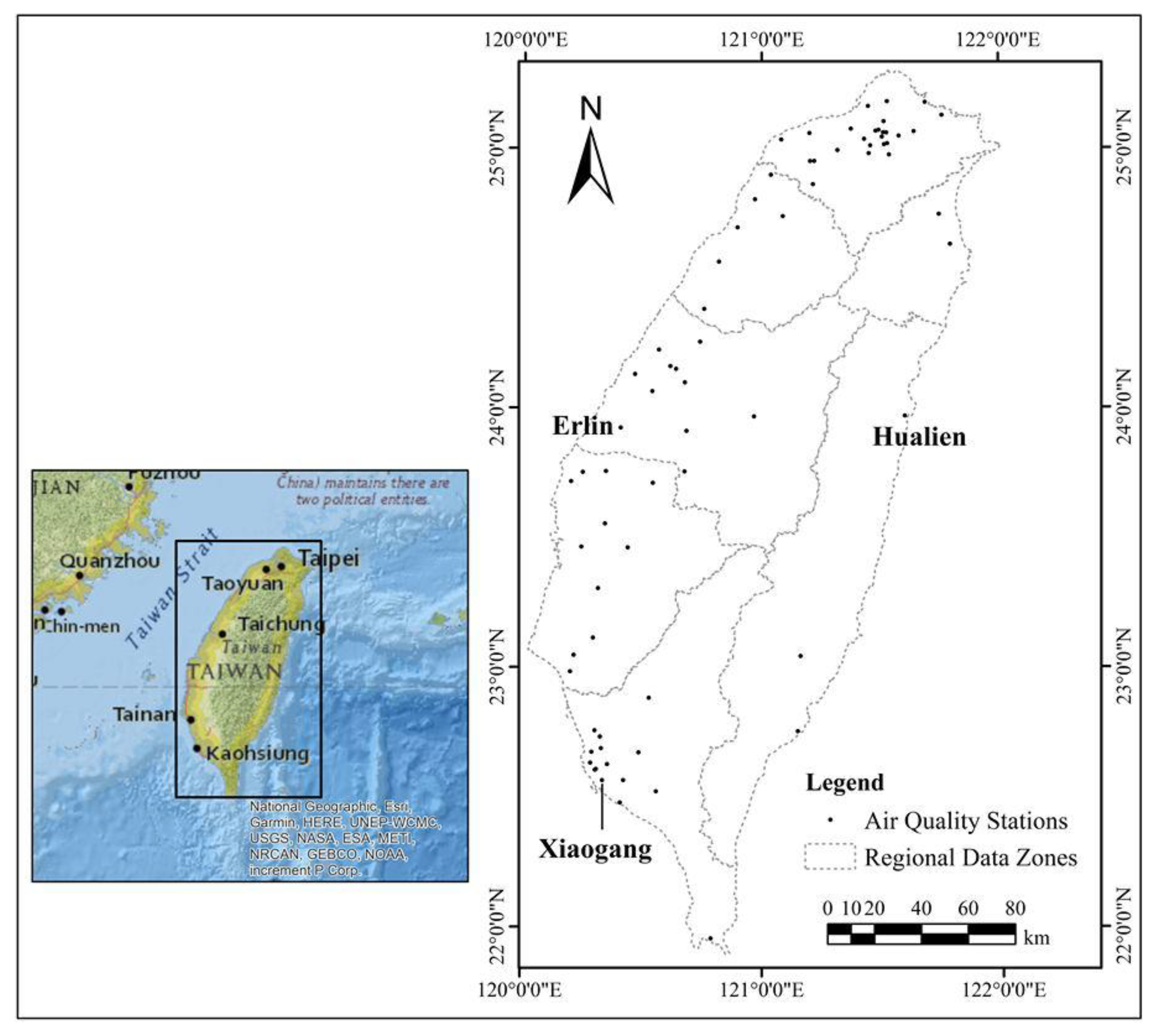
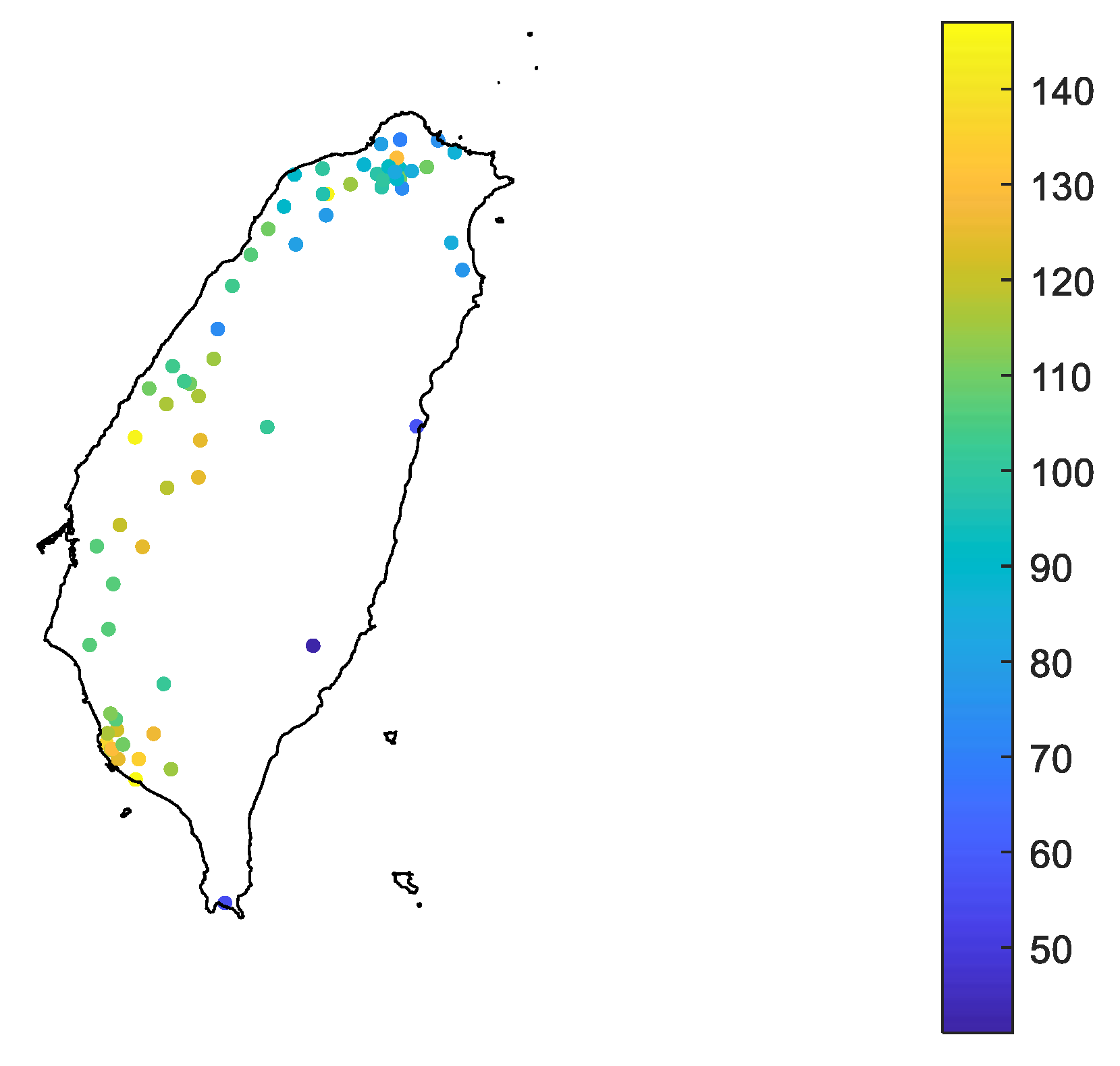
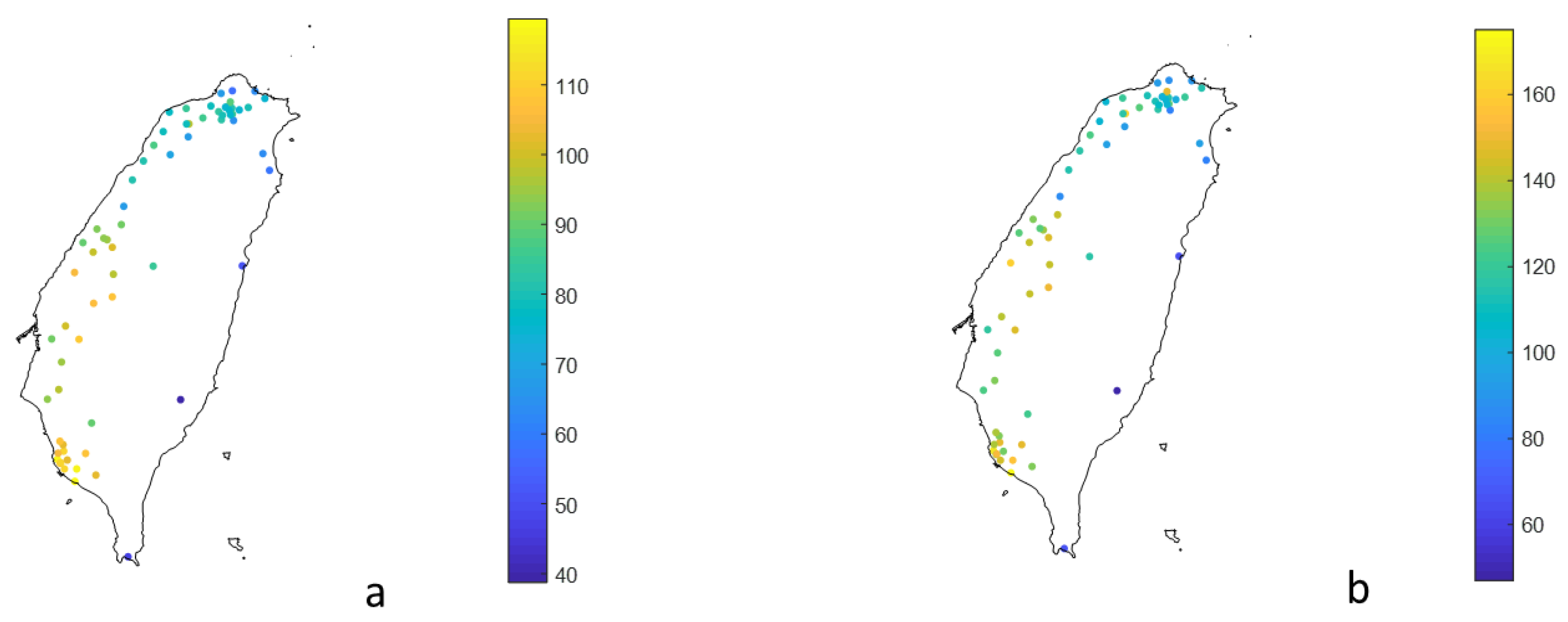


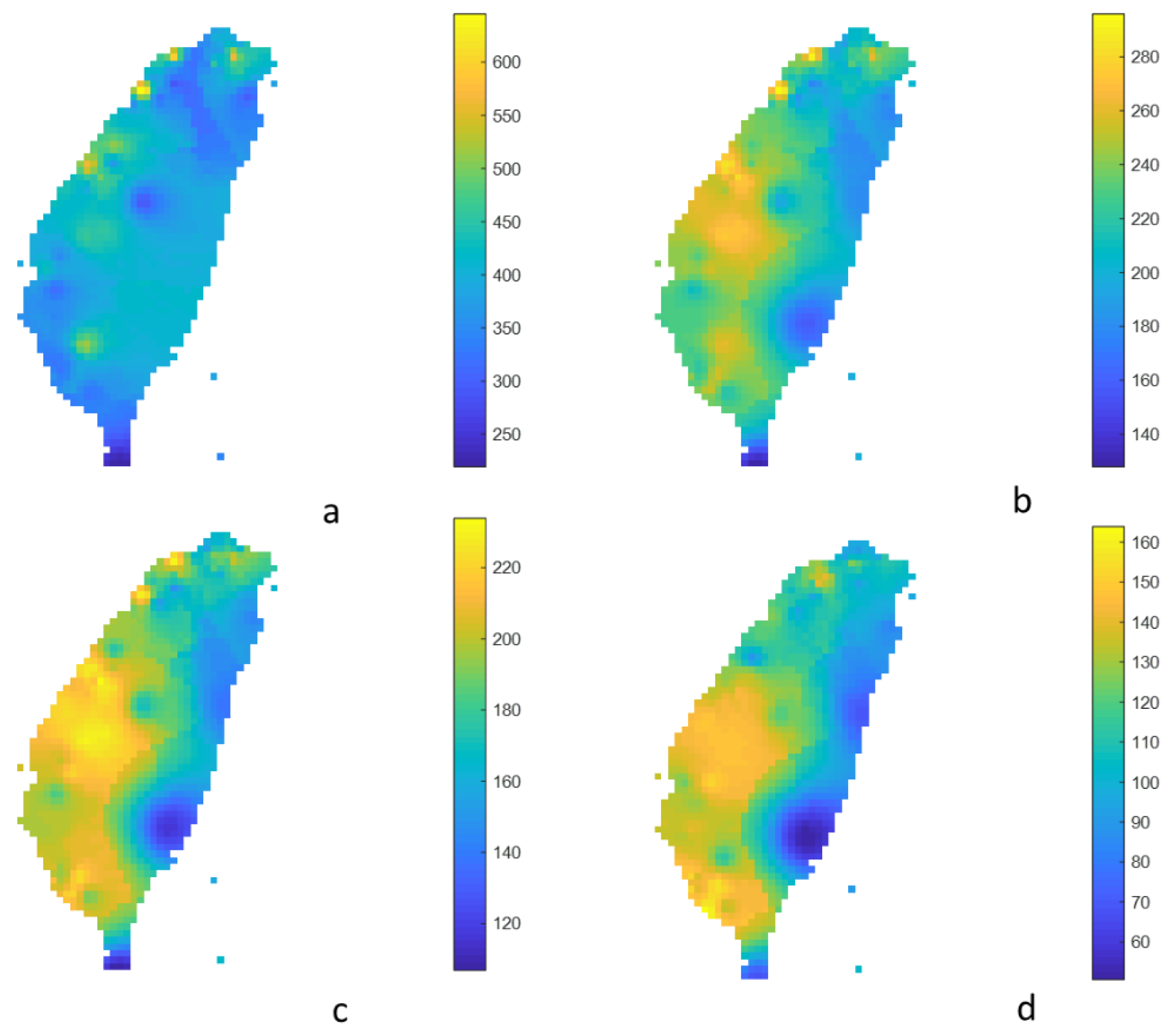
| Erlin | Hualien | Xiaogang | |
|---|---|---|---|
| k | 182.151 | 283.163 | 259.355 |
| 0.118 | 0.108 | 0.092 | |
| 0.154 | 0.424 | 0.219 | |
| R2 | 0.98 | 0.98 | 0.99 |
| RMSE (μg/m3) | 2.9 | 3.9 | 1.4 |
© 2020 by the authors. Licensee MDPI, Basel, Switzerland. This article is an open access article distributed under the terms and conditions of the Creative Commons Attribution (CC BY) license (http://creativecommons.org/licenses/by/4.0/).
Share and Cite
Chu, H.-J.; Ali, M.Z. Establishment of Regional Concentration–Duration–Frequency Relationships of Air Pollution: A Case Study for PM2.5. Int. J. Environ. Res. Public Health 2020, 17, 1419. https://doi.org/10.3390/ijerph17041419
Chu H-J, Ali MZ. Establishment of Regional Concentration–Duration–Frequency Relationships of Air Pollution: A Case Study for PM2.5. International Journal of Environmental Research and Public Health. 2020; 17(4):1419. https://doi.org/10.3390/ijerph17041419
Chicago/Turabian StyleChu, Hone-Jay, and Muhammad Zeeshan Ali. 2020. "Establishment of Regional Concentration–Duration–Frequency Relationships of Air Pollution: A Case Study for PM2.5" International Journal of Environmental Research and Public Health 17, no. 4: 1419. https://doi.org/10.3390/ijerph17041419
APA StyleChu, H.-J., & Ali, M. Z. (2020). Establishment of Regional Concentration–Duration–Frequency Relationships of Air Pollution: A Case Study for PM2.5. International Journal of Environmental Research and Public Health, 17(4), 1419. https://doi.org/10.3390/ijerph17041419






